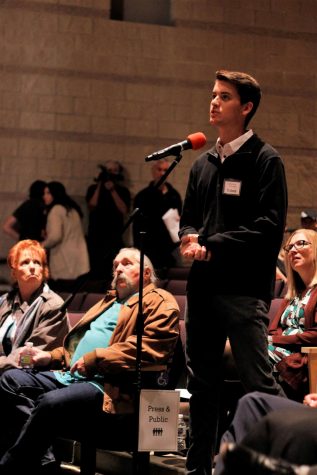Your donation will support the student journalists of Fossil Ridge High School. Your contribution will allow us to purchase equipment and cover our annual website hosting costs.
“All Rise”
October 20, 2018
As a four-year Journalism student, I’ve been learning how to ask the difficult questions for a long time. I’ve been to workshops, conferences from Colorado State University to San Francisco, and practiced over and over again. I’m still, however, not the type to rock the boat while looking straight into someone’s eyes.
When Fossil Ridge High School was picked to host Courts in the Community, I was thrilled. I’m considerably more politically active than your average high school student – one look at the number of articles in our opinion section with my name on them demonstrates it. I pride myself on always knowing what is going on in our world, and, perhaps as an idealistic seventeen-year-old, the democratic process gives me chills.
In addition, the Supreme Court is a critical entity. Their decisions set precedent that all lower courts must follow, and that fact wasn’t lost on me even as each senior in a government class muddled through packets that laid out the two cases that would be heard. It was fascinating to hear my peers comes to piecewise realizations – first, that any Supreme Court is an appellate court, rather than a trial one. Initially, the average one among us was almost certainly picturing a jury, a single judge with a podium and a gavel, and witnesses on the stand.
Second was the realization that the court would not be handing down a sentence, but ruling instead on the constitutionality of a process. Again, as teenagers with access to nearly every TV show imaginable, we pictured the defendant being hauled away in handcuffs before our eyes. The reality was, by some standards, far less exciting. Lawyers for each party explained their arguments to the court, who responded with questions that attempted to understand or prod.
Students filed into the Performing Arts Center the morning of October 18 with their friends, excited for a break in the everyday pattern of Thursday classes. The event could have been any other in a high school, with some people there because they had to be, some who were vaguely listening, and some who were legitimately curious about what they were about to learn.
When the bailiff said, “All rise”, though, everything shifted. Every high schooler in the room jumped to their feet with the quickness of a military cadet, not just to fit in but because power settled heavy in the PAC as the justices entered. There was complete and utter silence for those few moments, in which one could actually hear each young mind clicking with, “this is how history happens.” I was enraptured by the scene in front of me along with hundreds of my fellow Sabercats.

After each case, students were given the opportunity to ask questions of the attorneys. Pictured here, senior Jackson Holland asks a question after the Morehead hearing.
As the first argument began, though, I was honestly disappointed. The lawyers and justices conversed in language so thoroughly woven with legal jargon that it was unintelligible to most students. For the first five minutes, we gazed, wide-eyed, around at one another, trying to force our minds to comprehend what we were hearing and generally failing. Without turning my head, I could see three kids who were completely asleep – and I was sitting in the second row. The attitude in the room was not one of boredom but one of disappointment, because us students had truly been excited to be a part of this day.
However, the attitude shifted again when the arguments ended and students were allowed to come to the microphone and ask questions of the lawyers and of the justices themselves. I watched as my peers’ eyes became alight with excitement and inquisitiveness. They asked about the facts of the cases, how the court makes decisions, and why the lawyers said what they did.
My peers were daring, asking questions that directly poked holes in the lawyers’ arguments. There was a bit of mischief and a whole lot more curiosity in the way they approached the microphone, some confidently and others quietly, to find out how the justices and the lawyers got to where they are today and what steps we should take now to set ourselves up for the future.
My fellow students showed not only interest but awe. They were polite and respectful, all while asking questions I still would not think to today. They recognized Courts in the Community for what it was – not just a chance to miss class, but one to be a part of something much bigger. Not just to sit in Government and talk about the judicial process, but actually witness its effects.
My peers demonstrated that, for the reputation that teenagers are handed of being selfish and uninformed, they deeply care about democracy in our country. They questioned it, pondered it, participated in it. And they made me unimaginably proud.
